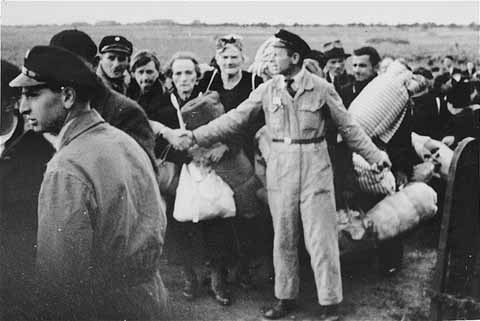http://www.jewishvirtuallibrary.org/jsource/Holocaust/westtoc.html
- Westerborkin leiri sijaitsi noin 15 km Westerborkin kylästä. Leirin aukaisivat (74 vuotta sitten) hollantilaisviranomaiset kesällä 1939 tarkoituksena ottaa sinne vastaan Saksasta tulevia pakolaisia. Ensimmäiset pakolaiset saapuivat lokakuun 9. päivä 1939. Saksalaisarmeijan invasoituessa Hollantiin oli leirillä 750 pakolaista.
The camp of Westerbork was situated about 15 km from the village of Westerbork. This camp had
been opened by the Dutch authorities during the summer 1939 in order to receive the Jewish refugees coming from Germany.
The first refugees arrived in Westerbork on October 9, 1939. When the
German army invaded Holland,
there were 750 refugees in the camp.
- Vuoden 1942 heinäkuun ensimmäisenä päivänä saksalaisviranomaiset ottivat leirin hallintaansa. Westerborkista tuli silloin "läpikulkuleiri". Heinäkuun 14. päivänä 1942 kaikki juutalaiset tutkittiin työkykyisyyden määrittelemiseksi. Ensimmäinen juna saapui 15. heinäkuuta ja lähti leiriltä 16. heinäkuuta valikoidut 1125 juutalaista mukanaan. Saman kuukauden loppuun mennessä oli noin 6000 Hollannin juutalaista tosiasiallisesti viety Auschwitziin ja heistä suurin osa kaasutettu kuoliaaksi. Tämän junan pääteasema oli Auschwitz. Toiset junat johtivat Bergen- Belseniin, Theresienstadtiin ja Vitteliin. Aluksi kuljetukset valmistettiin Hooghalenin asemalla. Marraskuussa 1942 ja sen jälkeen konstruoitiin uusia raiteita, joista junat tulivat leirille suoraan. Yli 103 000 juutalaista kuljetettiin Westerborkista Auschwitziin tai Sobiboriin.
On July 1, 1942,
the German authorities took control of the camp. Westerbork became officially
a "transit camp" (Durchgangslager Westerbork). On July 14,
1942, all the Jews were examined by the SS in order to determine who was able to work or not. The first train arrived
on July 15th and left the camp on July 16th with 1,135 of the first
selected Jews. By the end of the month, nearly 6,000 Dutch Jews had,
in fact reached Auschwitz,
where the majority were gassed. The destination of this train was Auschwitz
[other trains went to Bergen-Belsen, Theresienstadt, and
Vittel]. In the beginning, the transfers were done at the station of
Hooghalen. In November 1942, and after new rail lines had been constructed,
the trains arrived directly into the camp. More than 103.000 Jews were
transferred from Westerbork to Auschwitz or Sobibor.
- Westerborkin leiri oli hyvin outo paikka. Siellä oli koulu, kampaaja, orkesteri, täydellinen cabaree kuuluisine hollantilaisine taiteilijoineen piristämäsä vankeja - kaikki esitykset oli suoritettava saksankielellä- siellä oli jopa ravintolakin. Jos vangilla oli tarpeeksi rahaa, hän saattoi ostaa sellaistakin, mitä muualta Hollannista oli siihen aikaan mahdoton saada ostetuksi. Tällaiset ylellisyydet oli suunniteltu lieventämään kaikkia mahdollisia ongelmia, mitä Auschwitziin kuljetuksessa olisi voinut kehkeytyä. Moni vanki kuvittelikin, että olosuhteet jatkuisivat samanlaisina Puolan leirillä. Natseilla oli aina tapana jättää jonkin verran elossapysymistoivolle sijaa.
The camp of Westerbork was a very strange place. There
was a school, a hair-dresser, an orchestra [also a complete cabaret
group consisting of famous Dutch artists who tried to cheer up the inmates,
and were required to present all performances in German], and even a
restaurant. If a prisoner had enough money, it was possible for him
to buy goods that were impossible to find elsewhere in Holland at this
time. This "comfort" was designed by the SS in order to avoid
any problem during the transfers to Auschwitz. A lot of prisoners thought
that the condition of life would be the same in the camps of Poland.
The Nazis seemed to always leave just a little hope for survival.
 Members of the "OD", the Jewish Police, direct arriving Jews |
- Tämän leirin tarinassa kaikkein traagisinta oli se, että varsinaisilla SS saksalaisilla oli hyvin vähän suoraa interventiota kuljetettaviin: Selektiota suorittamaan asetettiin juutalaisista koottu turvallisuuspalvelu. Natsihallinto antoi määräyksen ja juutalainen hallinnollinen elin vain toimeenpani käskyn peläten joutuvansa itse poiskuljetettavaksi. Kuvitelkaa miten ironista, että juutalaiset ovat valikoimassa toisia juutalaisia varmaan kuolemaan. Kuljetuksia valvoi usein hollantilaispoliisi. Joka tiistai oli kuljetus tuhoamisleireille. Ennen tiistaita vallitsi leirillä paniikki. Joka ikinen vanki pelkäsi valintaa seuraavaan kuljetukseen. Niillä, jotka jäivät jäljelle, oli vain viikko aikaa seuraavan selektioon.
The most tragic part of the story of
this camp is that the SS had very little to do with the transfers:
the selections were made by a Jewish security service. The Nazi
commandant gave the orders; the Jewish "governing" body only carried
them out, in fear of themselves being deported. Imagine the irony,
Jews selecting other Jews for certain death. The transfers were often
done under the control of Dutch policemen. There was a transport to
the extermination camps every Tuesday. Before Tuesday, the camp was
in panic. Every prisoner feared selection for the next transport. On
Tuesday evenings, those who were not selected had just one more week
of rest before the next selection.
- Kuljetukset lopetettiin vuonna 1944 Liittoutuneitten vapautettua Westerborkin Silloin leirillä oli jäljellä 900 vankia. Vapautuksen jälkeen leiri on ollut täydellisesti tuhottuna. Siitä ei ole mitään jäljellä. Kuitenkin siellä on hyvin tuskallinen nonumentti ja erittäin mielenkiintoinen ja hyvin dokumentoitu muistomerkkikeskus sillä kohdalla. Monumentissa on pala rautatietä, joka on päädystään taivutettu osoittamaan kohti taivasta.
The transports stopped in September 1944.
When the Allies liberated Westerbork, 900 prisoners remained in the camp. The camp has been totally
destroyed after the liberation. Nothing remains of the camp. However,
there is a very poignant monument and a very interesting and well documented
memorial center at the site. The monument consists of a piece of railroad
track, which at its end is twisted and points into the sky.
http://www.jewishvirtuallibrary.org/jsource/Holocaust/WesterborkMonumentPhotos.html
http://www.jewishvirtuallibrary.org/jsource/Holocaust/WesterborkMonumentPhotos.html
Inga kommentarer:
Skicka en kommentar